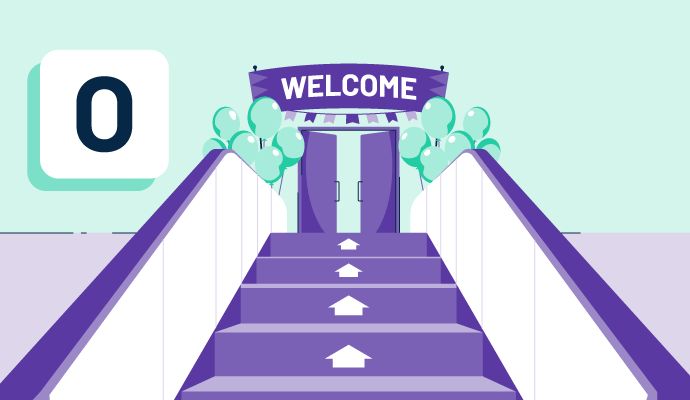What is onboarding?
Onboarding is the process of supporting and integrating new employees into an organization. The HR team typically manages the complete process and eases the transition for new hires by providing them with all relevant documentation, materials, and training needed. In addition to training on the job itself, the process allows businesses to introduce new team members to the company culture.
HR teams leverage onboarding software to coordinate and streamline the onboarding process. These tools eliminate paperwork trails and consolidate the experience in one centralized hub.
Stages of onboarding
Employee onboarding is not a one-and-done activity. There are five stages of the process that help employees navigate the first year with an organization. The five stages include:
- Pre-first day preparation: The onboarding process should begin before an employee’s first day. During this stage, HR should provide the new hires with all the information they need for their first day. This might include sending a welcome email, creating a plan for the first week of employment, and working with IT to grant technology tools and software access. Preparation information should also include time and location details for the first day.
- First-day orientation: A new hire’s first day at an organization can be exciting and overwhelming. Orientation day can include activities like a welcome breakfast, office tour, introduction to the team, completing necessary paperwork such as tax and payroll forms, and an overview of the company. This stage ensures a new hire feels welcome and receives access to the systems and information they need.
- End of the first week: After orientation day, HR and other teammates should help new hires integrate into the team and learn the basics of their new role. The first week might involve one-on-one meetings to get to know teammates, daily check-ins with the hiring manager, and quiet time to self-train or read through company materials.
- 90-day check-in: Many organizations follow a 90-day introductory time frame to allow new hires to get adjusted and settled. At the end of 90 days, HR should check-in with the employee to find out how their transition is going. Additionally, managers should provide feedback and discuss performance with the employee to help them visualize success, foster employee development, and set longer-term goals.
- One-year milestone: At the end of an employee's first year, they should have a quick review with their manager. At the one-year mark, managers should provide feedback on the employee’s work and ask for input on the hiring and onboarding process. Additionally, managers and teams should celebrate and recognize one-year anniversaries as the final mark of the onboarding process.
Benefits of onboarding
Organizations that implement a practical onboarding experience will likely see specific results. There are many benefits of this type of employee program, including:
- Establish and build trust. Employers can establish and build trust with their employees by ensuring they feel supported as soon as they begin their new role. Frequent and open communication and a structured training plan throughout the onboarding program contribute to building trust with new hires.
- Enable new team members to hit the ground running in their roles. An effective onboarding plan helps employees understand job expectations from the beginning. With the proper steps in place, an organization can train employees quicker to perform right away. Doing so can help shorten the learning curve for new hires.
- Attract top talent and build strong teams. The hiring experience gives new hires a taste of what’s to come. A positive onboarding process often translates into an employee’s long-term experience and influences whether they refer others to the organization. Companies can attract top talent and build top-notch teams with a robust onboarding plan that gives employees everything they need to succeed.
- Increased employee engagement. A well-designed and fun onboarding experience will engage a new hire from the beginning. Employee engagement can help a new team member assimilate into the company culture and their team successfully, leading to better output and employee relations.
- Promoting an organization’s company culture. Understanding a company’s culture helps employees be more successful in their work. Onboarding is a perfect avenue for organizations to introduce and promote their company culture to new team members so they can adopt shared values, beliefs, and attitudes in their new roles.
Onboarding best practices
One perk of employee onboarding programs is that organizations can customize them to fit the immediate needs of the business. However, all companies should follow some general best practices, no matter the format or structure of the onboarding program. Take the following into account for the best results:
- Make the first day memorable and fun. Many employees never forget their first day at a new job. Help new hires feel comfortable, confident about their decision to accept their new position, and have fun. Consider providing a welcome package with company swag on their first day.
- Keep it consistent. Create an onboarding process and stick to it to maintain consistency across all departments. Utilize new hire checklists to ensure no steps get missed along the way.
- Be reasonable with training expectations. Avoid inundating new team members with too much information so they don’t feel overwhelmed and drained right away. Instead, set a reasonable pace for training and provide breaks as often as possible to allow for time to process and digest the new information.
- Minimize surprises and eliminate guesswork. Don’t leave areas of opportunity for new hires to guess what they should be doing and when. It’s up to HR teams and hiring managers to own the process and communicate it accordingly.

Alyssa Towns
Alyssa Towns works in communications and change management and is a freelance writer for G2. She mainly writes SaaS, productivity, and career-adjacent content. In her spare time, Alyssa is either enjoying a new restaurant with her husband, playing with her Bengal cats Yeti and Yowie, adventuring outdoors, or reading a book from her TBR list.





















